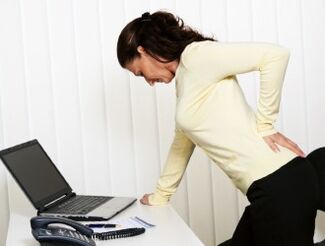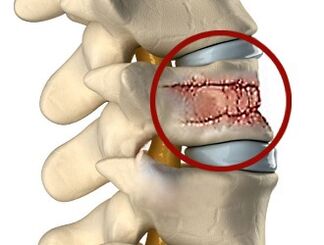
Almost everyone is familiar with back pain., and 15-20% have to deal with these symptoms regularly throughout the year.
The problem is not only medical, but also socio-economic, because during illness, the patient, depending on the causes that cause the problem, loses his ability to work.
In most cases, it is possible to get rid of the disease in a month, after which the patient can resume a normal life.
Despite these results, in 70% of patients the pain returns, the treatment is useless because the therapy is incorrect or insufficient.
It should be noted that painis a sign of degenerative processes in the spine, which in turn is considered a sign of a pathological condition.
Classification and nature of back pain
Types of back pain:
- not specific(benign) - dorsopathy, "outdated" osteochondrosis, the most frequent cause is dysfunction of the musculoskeletal system, additional examinations are most often useless;
- specifically(dangerous) pain that requires additional diagnostics at the first visit, which makes it possible to exclude the presence of spinal fractures, tuberculosis, tumors, metastases, etc. ;
- radicular pain(radiculopathy) - associated with nerve root irritation / compression by a herniated (falling) disc.
What diseases of the musculoskeletal system cause pain in the spine in the middle of the back?
Diseases of the musculoskeletal system that cause pain:
- osteoarthritis- the patient can bend over from pain, try to straighten his back, breathing deeply contributes to an increase in negative sensations, when squeezing the vertebrae, the load on the elastic shock-absorbing pad increases, as a result, the damaged element becomes thinner;
- chondrosis, osteochondrosis of the thoracic region- develops against the background of obesity, physical inactivity, unbalanced nutrition, mineral metabolism disorders, in the process of age-related changes, the elasticity and height of the intervertebral disc decreases, changes in its structure, pinching of nerve fibers contribute suddenly, severe pain or moderate discomfortwhich is aggravated by movement;
- scoliosis, increased/decreased lordosis, kyphosis- leads to deterioration in posture and appearance, resulting in pinched nerves in the spine;
- pole injury;
- neurological cause(radiculitis);
- congenital pathology- extra / missing vertebra in the spine leads to painful discomfort;
- myositis- weakening and increasing pain develops on the background of skeletal muscle inflammation, discomfort increases with back palpation.

Other causes of back pain
Another reason:
- kidney inflammation- discomfort is often accompanied by high fever, swelling of the lower legs, hypertension;
- diseases of the cardiovascular system, vascular pathology - accompanied by throbbing back pain and increased blood pressure;
- chronic stress;
- diseases of the digestive system- the pain is localized in the middle or on the left side of the back, after eating the pain increases against the background of pancreatitis or diseases of the gastric mucosa;
- psycho-emotional disorders.
Serious diseases of the organs located in the abdominal cavity and below the chest can also respond to pain in the spine. It is often very difficult for the patient to establish the nature of the pain, it is recommended to monitor the symptoms and inform the doctor in time.
Treatment of pain in the spine
Before starting treatment, the doctor must make a diagnosis, study the patient's history, listen to complaints, conduct a visual examination and palpation, review laboratory results and diagnostic studies. After that, the selection of the necessary drugs is carried out, actions aimed at correcting the problem.
Preparation
During an exacerbation, therapy aims to stop the pain signal.
Medicines:
- Nonsteroidal anti-inflammatory drugs- their action aims to stop mediators of the inflammatory process before they enter the tissue around the spine. It helps to relieve inflammation, fever, swelling, spasms, pain. In case of severe pain, an injection preparation is prescribed, it is distinguished by its quick effect (15-20 minutes), safety for the gastrointestinal tract, all components are delivered in initial doses. To relieve moderate and mild pain, external preparations or drugs in oral form are prescribed.
- Analgesic- prescribed when the analgesic properties of NSAIDs are insufficient, the drugs affect the transmission of nerve impulses to the brain, which prevents the occurrence of a reaction. The combination of 2 groups is recommended to be carried out with caution, body characteristics, drug compatibility should be taken into account, dose selection is done individually.
- Relax the muscles- diseases of the spine are often accompanied by muscle spasms, which force the patient to freeze in one position, all movements lead to sharp pain. A muscle relaxant injection will help relax the muscle corset, the effect of its administration lasts for 12 hours. Tablets are used less often, because they begin to work only after the collection of the necessary amount of ingredients.
- Chondroprotectors- problems with the spine appear on the background of degenerative processes in the articular tissue and cartilage, in such cases drugs containing chondroitin or glucosamine are prescribed. The material is the basis for the restoration of tendons, joints, ligaments, etc. This component is not produced in the body, therefore, during illness, the cells should be as saturated as possible with the listed substances, often they are prescribed orally, drugs should be taken in a long course.
As an adjunctive therapyvitamin complexes, diuretics, antispasmodics can be prescribed, as well as funds aimed at increasing trophism and restoring blood circulation, antioxidants, antihistamines and others.
Surgery
If there is no effect of drug treatment, surgical treatment is indicated, modern techniques can achieve great results.With osteochondrosis, injury and hernia, part of the vertebra or intervertebral disc is removed, with aortic aneurysm, plasty is indicated.
In diseases of the spine, the original cause of pain should be established; often, the source of unpleasant symptoms is internal organs. Only a doctor can diagnose the disease and prescribe treatment.
Exercise, exercise therapy, massage
If the patient's condition and the nature of the underlying disease course allow, moderate physical activity is required.
Doctors also recommend regular, complex morning exercises including the following exercises:
- child posing. Sit on your knees with your head bowed to the floor, stretch your arms forward, stay in this position for 20 seconds, stretch your arms back also for 20 seconds, repeat the exercise twice.
- Head down.Sit on the floor with a straight back, put your hands behind your head, slowly pull your head forward, tilt it until your chin touches your neck, hold for 10-15 seconds, repeat 8-10 times.
- Twisting with a stick. In a standing position, place the gymnastic stick in a horizontal position on the neck behind the head, stretch your arms and hold the end of the stick. With the stick behind your head, slowly turn to the left, hold for 25-30 seconds, repeat in the opposite direction, the number of repetitions is 10-12 times.
- The body leans forward. With feet placed shoulder-width apart and hands clasped behind the keys, stand up, lean forward, bend your legs slightly at the knees, stay in this position for 15-20 seconds, repeat up to 4-5 times.
- Body leans forward with toes touching. Sit on the floor, close your legs, place them in front of you, bend forward to reach your toes with your hands. Exercise should be done without sudden movements, gradually, slowly, hold in position for a few seconds.
During an exacerbation, exercise therapy and other types of physical activity are strictly prohibited.
massage
Manual massage has also shown effectiveness in back pain caused by spinal disease.. The technique allows you to achieve muscle relaxation, during its implementation, soft tissue is heated, which helps improve blood circulation. Such a massage is recommended for patients with pathologies of the respiratory organs, accompanied by the release of phlegm.
Treatment at home or folk remedies
In the presence of persistent back pain, it is recommended to turn to folk recipes, before using them, you should consult a doctor. Although it seems safe, many ways are not only useless, but also dangerous.
Recommended for pain reliefprepare a smear. To do this, you need to take a mixture of pure alcohol or cologne, a little hot pepper, valerian root tincture, a bottle of 5% iodine solution, rub the affected area thoroughly with the mixture, wrap it. This procedure is recommended to be carried out at night, left warm until morning. It is very important not to start this disease, to identify the cause of the pathology in time and follow all the doctor's recommendations.
The following steps can help alleviate the situation at home:
- avoid staying in bed for a long time - physically active patients experience less pain;
- engage in light sports - moderate physical activity is best;
- maintain proper posture;
- increase the flexibility of the spine;
- wearing corsets and belts for the spine;
- apply heat and cold to the affected area;
- stop smoking - nicotine causes spasm of small vessels, which leads to disruption of microcirculation and cessation of oxygen delivery to tissues;
- relaxation exercises.
Prevention
The patient can prevent the development of back disease himself, he must learn to sleep, sit and stand correctly, as well as bear heavy loads with minimal damage to himself. It is recommended to stand and sit with a straight back, the head should not hang forward, a person should not bend and bend the body without relying on the hands.
If you have to be on your feet for a long time, you should find a point to support your head and limbs, you can lean on a cupboard, wall and other surface. Walking with heels for more than 2 hours in a row is not included, the feet should rest periodically, for this they should be lifted for several minutes.
Preventive measures:
- unload the neck and lower back with a special roller or "bone" pillow, avoid sitting on a stool or with a bent back, every 15 minutes. you should change posture, stretch and lean, after every hour of sitting you need to rest;
- you need to sleep on a hard mattress without a high pillow, you can put an orthopedic roller under your head;
- when carrying loads, certain rules must be followed, loads of more than 3 kg for women and more than 5 kg for men cannot be carried, it is dangerous to lift loads while bending or jerking, bags should be lifted with a straight back, heavy loads should be carried in severalsteps.
Conclusion
- Backache- quite common pathology, with the appearance of pain syndrome, you should seek medical help.
- Pathological causes are very different, the doctor makes a diagnosis based on anamnesis, examination, patient complaints.
- During treatmentdrugs are used(mainly painkillers), it is recommended to carry out massage, exercise therapy.



















